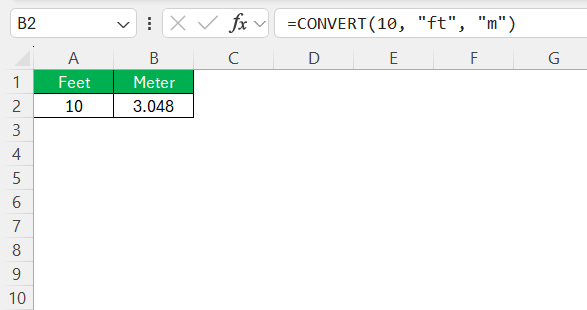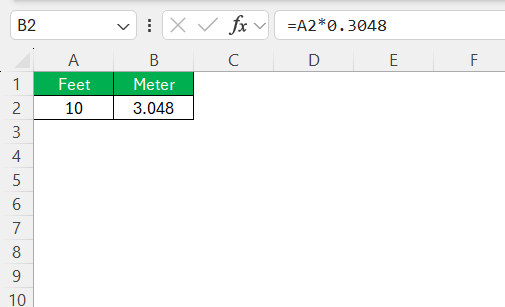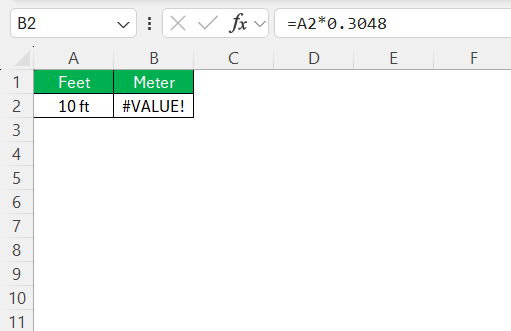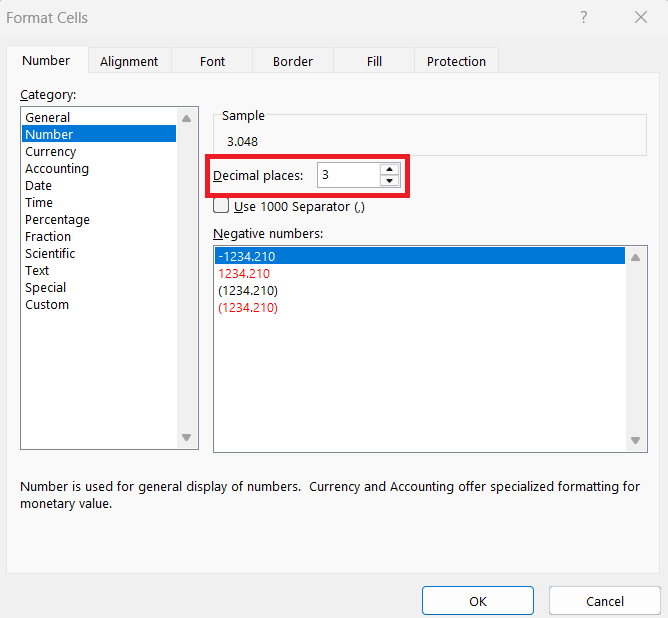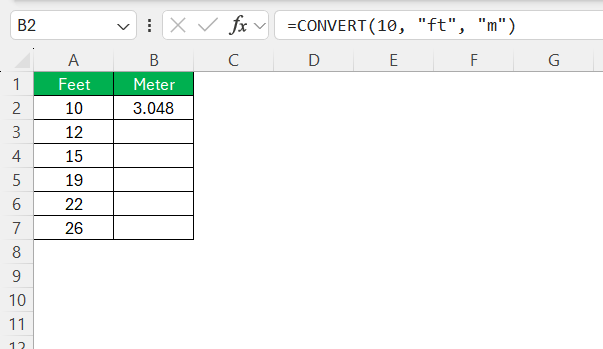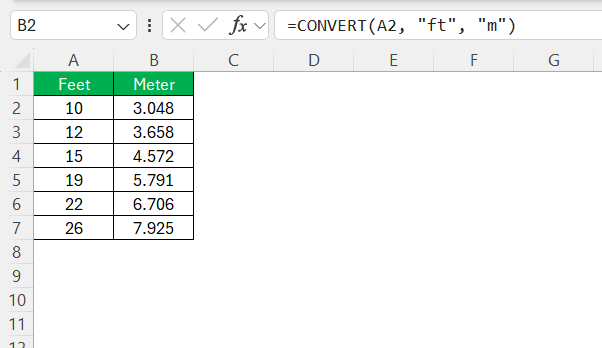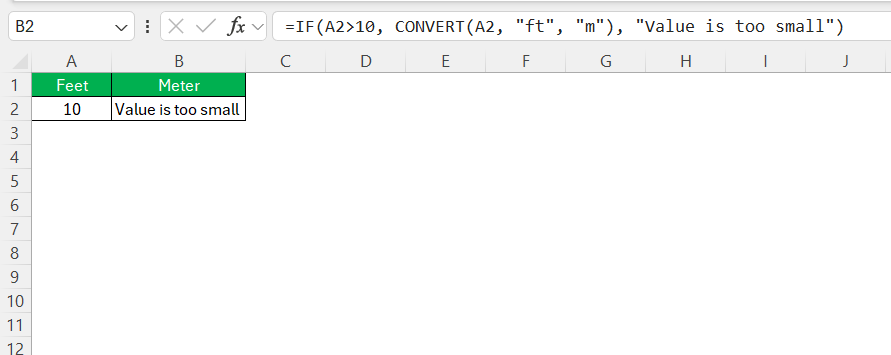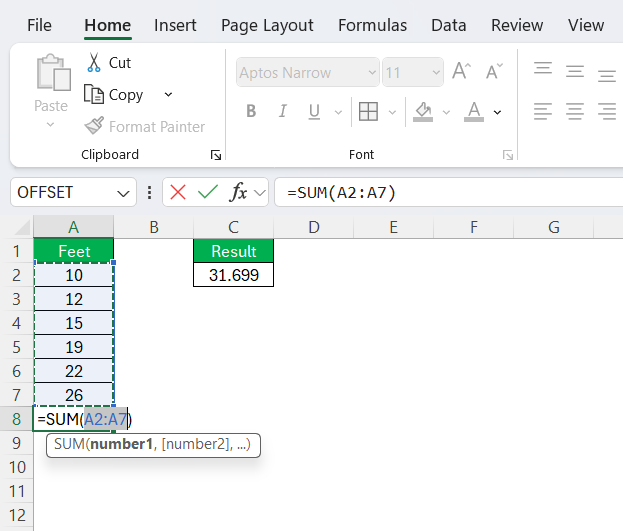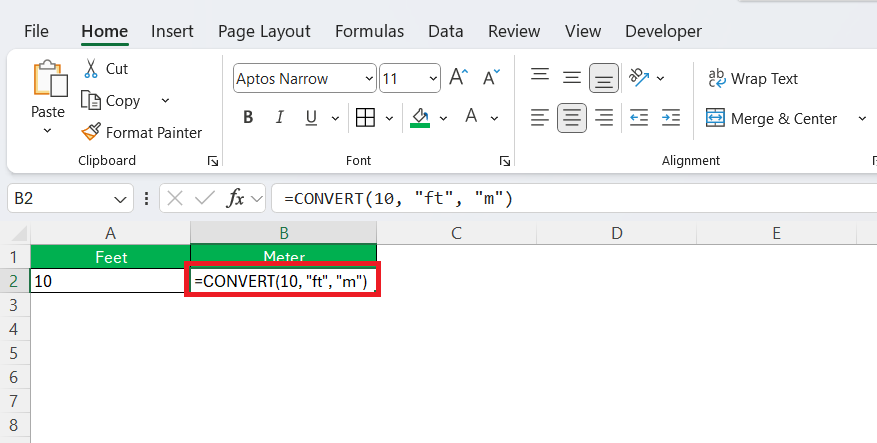Microsoft Excel is an incredibly powerful tool, renowned for its versatility and ability to streamline complex calculations. One common task users encounter is the need to convert measurements—in this case, ft to m. This guide will explore various methods, detailing both basic approaches and advanced techniques to enhance your efficiency and accuracy when using Excel for this purpose.
Key Takeaways:
- One foot equals 0.3048 meters, and Excel can convert this easily using the CONVERT function.
- Use =CONVERT(value, “ft”, “m”) for fast and accurate conversion of feet to meters.
- The Fill Handle and formula builder help automate conversions and reduce manual errors.
- Common issues like formula errors and formatting conflicts can be fixed by checking syntax and decimal settings.
- Excel shortcuts like Ctrl + D and F2 speed up conversions and boost efficiency in large datasets.
Table of Contents
The Basics of Excel Conversion
Understanding Measurement Units
Measurement units are fundamental to various fields, such as science, engineering, and construction, providing standard dimensions for communication and analysis. The foot (ft) is widely used in countries like the United States to measure length, whereas the meter (m) is the international metric standard used globally. Converting between these units is necessary for global consistency and interoperability.
One foot is equivalent to approximately 0.3048 meters, a conversion that Excel handles seamlessly with the right formula.
Why Use Excel for Unit Conversion?
Excel is a preferred choice for unit conversion due to its intuitive interface and robust computational capabilities. It simplifies the conversion process with built-in functions like CONVERT, which handles various unit transformations effortlessly. Excel’s capacity to process large datasets quickly means you can convert multiple measurements simultaneously, a significant advantage over manual calculations.
Moreover, its adaptability allows you to customize and automate tasks, enhancing productivity and reducing human error.
Step-by-Step Guide to Converting ft to m
Using the CONVERT Function
The CONVERT function in Excel is a powerful tool designed for transforming values across different measurement systems. This function requires three arguments: the number you wish to convert, the unit you’re converting from (from_unit), and the unit you’re converting to (to_unit). For instance, to convert 10 feet to meters, you would use the formula: =CONVERT(10, "ft", "m").
This function automatically performs the necessary calculations, ensuring accuracy. It’s essential to remember that the CONVERT function is case-sensitive, so unit identifiers must be entered correctly to avoid errors.
Manual Entry vs Formula Builder
When converting units in Excel, you have the choice between manual entry and using the formula builder. Manual entry involves typing the formula directly into the cell, which provides flexibility and quick adjustments for simple tasks.
However, this method demands precise input to avoid errors.
On the other hand, the formula builder offers a guided interface. It helps ensure accuracy by presenting a structured environment for selecting functions and their arguments. This can be particularly advantageous for those less familiar with formulas or when dealing with complex calculations. Each method has its pros and cons; manual entry is faster for straightforward conversions, whereas the formula builder minimizes the risk of errors in more elaborate tasks.
Troubleshooting Common Errors
Even the best Excel users encounter hiccups from time to time. Whether it’s a formula error or a formatting mishap, knowing how to troubleshoot common issues can save you a lot of frustration. Let’s tackle some typical problems you might face and how to resolve them.
Common issues include:
- Formula Errors: If you see a #VALUE! or #NAME? error, double-check your formula syntax and cell references. Ensure cells are correctly referenced and the function arguments are valid.
- Decimal Precision: If your results seem off, verify the number of decimal places displayed. Excel might be rounding without your knowledge, so adjust cell formatting to show more decimals if necessary.
- Formatting Conflicts: Ensure that your cells are formatted consistently. Mixed formats can confuse Excel and lead to unexpected results, particularly if you’re copying or referencing cells from different formats.
By understanding these common pitfalls, you can quickly diagnose and fix issues, keeping your workflow smooth and efficient. Remember, even seasoned Excel users run into problems, so don’t be discouraged!
Advanced Excel Techniques for Easier Conversion
Automating Multiple Cell Conversions
Automating conversions across multiple cells in Excel can significantly boost your efficiency, especially when handling large datasets. Utilizing the Fill Handle is a straightforward method to propagate the CONVERT function across a range of cells. Here’s how you can do it effectively:
- Initial Setup: Enter the CONVERT formula in the first cell of the range you want to convert. For example, if you’re converting values in column A, place the formula in cell A2 as
=CONVERT(A2, "ft", "m").
- Fill Handle Usage: Click and hold the small square at the bottom-right corner of the formula cell (known as the Fill Handle). Drag this handle down to apply the formula to adjacent cells beneath. Excel will automatically adjust the cell references to match each row, maintaining accuracy.
- Verify Results: Once applied, double-check the converted values to confirm that the formula was correctly propagated across all cells. Spot-check a few entries to ensure consistency and accuracy.
This method not only simplifies converting large volumes of data, but it also minimizes human error and ensures uniformity across your data set.
How to Integrate with Other Excel Functions
Integrating conversion formulas with other Excel functions enhances your data analysis capabilities and streamlines complex tasks. Here’s how to combine conversion functions, like CONVERT, with other powerful Excel features:
- Using SUMPRODUCT for Batch Operations: If you need to sum a series of converted values, incorporate SUMPRODUCT. For example, use
=SUMPRODUCT(A2:A7 * 3.048)to add the converted values in one go.
- Leveraging IF Statements: Combine conversions with IF statements to apply conditional logic. For example,
=IF(A2>10, CONVERT(A2, "ft", "m"), "Value is too small")converts only if the input exceeds a threshold.
By integrating these techniques, you unlock Excel’s full potential, allowing for more sophisticated data manipulations and providing deeper insights into your datasets.
Practical Applications and Use Cases
Real-World Scenarios
Converting feet to meters is relevant in numerous real-world applications, cutting across various industries and daily activities. Understanding these scenarios helps illustrate the practical importance of mastering this conversion in Excel.
- Construction Projects: In construction and architecture, plans might be drafted in feet, but many international standards require meters. Utilizing Excel’s conversion features allows seamless translation of measurements for global compliance.
- Event Planning: For event coordinators managing spaces and layouts, venue dimensions might be provided in different units. Converting these measurements ensures accurate planning, whether in designing seating arrangements or planning stage setups.
- Academic Research: Students and researchers across disciplines often need to harmonize datasets from diverse sources. Excel makes it easy to convert units systematically, thereby maintaining consistency across research findings and facilitating accurate analyses.
- Shipping and Logistics: Companies that transport goods internationally deal with varying unit standards. Converting cargo dimensions to meters ensures clarity and compliance with international logistics requirements, optimizing space and resources.
- Engineering and Manufacturing: Engineers and manufacturers routinely manipulate designs and specifications that require precise conversions to meet international tolerances and standards.
These scenarios exemplify where precise unit conversion is not just beneficial but essential for success.
Industry-Specific Examples
Industry-specific examples emphasize how critical unit conversions, such as feet to meters, can be. Each industry utilizes these conversions in unique ways to meet their operational needs and comply with standards.
- Aerospace: Engineers designing aircraft must often convert measurements to ensure components fit within metric specifications for international markets. Conversions support precision engineering where even the smallest error can have significant consequences.
- Healthcare and Medicine: Medical equipment often comes with specs and manuals in metric units, while some procedures may involve measurements in feet. Accurate conversion is essential for safe and effective patient care.
- Automotive Manufacturing: Global car manufacturers use Excel to convert designs drafted in feet into metric systems to meet the diverse regulatory standards of each country where they operate.
- Environmental Science: Scientists engaged in ecological assessments may convert between feet and meters when analyzing elevation data, streamflow measurements, or habitat dimensions to align with global databases and initiatives.
- Telecommunications: Cell tower placements and signal range often require conversion calculations to convert feet to meters, helping technicians and planners design effective communication systems across international sites.
These examples underscore how vital precise conversions are across various sectors, directly impacting product quality, regulatory compliance, and operational efficiency.
Tips and Tricks for Efficient Conversions
Keyboard Shortcuts
Keyboard shortcuts in Excel greatly enhance efficiency, streamlining the conversion process and improving overall workflow. Here are some essential shortcuts to expedite your unit conversion tasks and general navigation:
- Quickly Access Functions: Press
Alt + =to automatically insert the SUM function, which you can then adapt to include your conversion formula.
- Auto-Fill Formulas: Use
Ctrl + Dto fill the formula down through a column orCtrl + Rto fill it across a row, ideal for applying conversions across multiple cells effortlessly. - Navigate with Ease:
Ctrl + Arrow Keyshelps you quickly move to the last cell in a data region in any direction, allowing fast navigation between sections of your worksheet. - Edit Cells Efficiently:
F2enables quick editing of the active cell, letting you update conversion formulas without switching between mouse and keyboard. - Toggle Between Formulas and Results:
Ctrl + ~displays all formulas in your worksheet, helping you cross-check and verify that your conversion formulas are entered correctly.
Mastering these shortcuts can significantly reduce the time spent on repetitive tasks, allowing you to focus on analyzing the results.
FAQs
What is the formula to convert ft to m in Excel?
To convert feet to meters in Excel, use the CONVERT function. The formula is =CONVERT(cell_reference, "ft", "m"). Replace cell_reference with the specific cell containing the value you want to convert. This function handles the conversion accurately, making it a reliable tool for measurement transformations.
Can I convert other units using a similar method?
Yes, you can convert a wide range of units using the CONVERT function in Excel. Simply replace the “ft” and “m” in the formula with the appropriate unit codes for what you need. This versatile function supports conversions across weight, distance, volume, temperature, and more, ensuring broad applicability.
What should I do if the conversion doesn’t work?
If the conversion doesn’t work, first check for any syntax errors in your formula, ensuring unit codes are correctly inputted and case-sensitive. Verify that the units are compatible; incompatible units will cause errors. Also, ensure the Analysis ToolPak is installed, as it includes essential Excel functions like CONVERT.
How to do unit conversion in Excel?
To perform unit conversion in Excel, use the CONVERT function. Enter =CONVERT(number, from_unit, to_unit) in a cell, replacing “number” with the value to convert, “from_unit” with the original unit, and “to_unit” with the target unit. This function supports diverse units, automating and simplifying conversions.
What is the formula for feet to meters?
The formula to convert feet to meters in Excel is =CONVERT(value, "ft", "m"). Replace “value” with the cell reference containing the feet measurement you wish to convert. This function automatically performs the conversion, ensuring accurate results every time.
John Michaloudis is a former accountant and finance analyst at General Electric, a Microsoft MVP since 2020, an Amazon #1 bestselling author of 4 Microsoft Excel books and teacher of Microsoft Excel & Office over at his flagship MyExcelOnline Academy Online Course.

